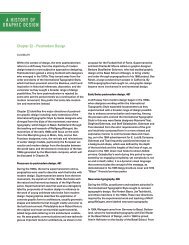Week 2 National Visions within a Global Dialogue - A History of ...
Week 2 National Visions within a Global Dialogue - A History of ...
Week 2 National Visions within a Global Dialogue - A History of ...
You also want an ePaper? Increase the reach of your titles
YUMPU automatically turns print PDFs into web optimized ePapers that Google loves.
A HISTORY OFGRAPHIC DESIGNconditions. Design education and practice has becomean extraordinarily rich field, with a unique visual languagefor the rapidly growing environment <strong>of</strong> cross-culturaldialogue and collaboration, which advances China’sobjective <strong>of</strong> becoming a leader in the design industry.Henry Steiner and Bingnan Yu, pioneers <strong>of</strong> contemporaryChinese graphic design, embrace modern designand continue to inspire a younger generation <strong>of</strong> graphicdesign. Steiner is among the earliest Western-trainedmodern designers, having studied at Hunter College inNew York and later at Yale University. Practicing in HongKong, his work has had significant influence in the PacificRim. Bingnan Yu first studied art at the LuXun Academy<strong>of</strong> Fine Arts in China and continued his educationat the Hochschule für Grafik und Buchkunst in Leipzig,Germany. As a teacher, he emphasizes the significance <strong>of</strong>traditional Chinese arts, painting, and calligraphy as wellas the principles <strong>of</strong> both his Eastern and Western designeducation.Min Wang is leader in the Chinese embrace <strong>of</strong> Westerndesign movements, in both education and practice. Educatedat Zhejiang Academy <strong>of</strong> Fine Arts, he later studiedwith Alvin Eisenman and Paul Rand at Yale University.At Yale, he developed a strong cross-cultural perspectivethat would prove a prescient design strategy uponhis return to China. His ability to fuse East and West isclearly evident in his work, and most notably, in the 2008Beijing Olympic Games graphics program, for which heserved as design director.Jingren Lu is one <strong>of</strong> China’s most influential book designersand illustrators. His designs emphasize the bookas an interactive three-dimensional object and his use<strong>of</strong> unique materials, elegant bindings, and incised covertreatments draws on China’s rich esthetic traditionsand expressively joins them with postmodern Westerndesign.Among the new generation <strong>of</strong> Chinese graphic designerswho embody a developing contemporary aestheticare Jiaping He, whose posters are a remarkable blend <strong>of</strong>type and photography and retain the majesty and serenity<strong>of</strong> traditional Chinese landscape painting; Hua Jiang,who explores modern Chinese typography (Meishuzi)and its development, basic structure, history, and calligraphictradition; Jian Zhao, a book designer and formerstudent <strong>of</strong> Jingren Lu, who frequently blends Chinese illustrationswith typography; Fang Cao, whose work presentsancient Chinese themes and rich cultural symbolismthrough complex layering <strong>of</strong> repetitive hand-drawings,musical notes, Western typography, Chinese calligraphy,and photographs; Xu Wang, whose expressive designsreflect the grace and beauty <strong>of</strong> traditional Chinese brushpainting; Tommy Li, whose work combines a decidedlypostmodern visual emphasis, including layered, textured,and deconstructed digital elements, with elementsfrom his Chinese artistic heritage; and Stanley Wong,whose designs juxtapose Chinese esthetics and modernvisual language to emphasize social messages that frequentlycall attention to interpersonal human relations.Graphic design in the former Portuguese colony <strong>of</strong> Macaudisplays both Iberian and Chinese influences. UngVai Meng, a native <strong>of</strong> Macau, was educated in Portugaland China. His work <strong>of</strong>ten combines skillful yet expressionisticuse <strong>of</strong> the pen, infusing his posters with asense <strong>of</strong> freedom, lightness, and jubilance. Victor HugoMarreiros, also a native <strong>of</strong> Macau, studied in Portugal.In 1998 he began Victor Hugo Design where his workcontinues to maintain a link between his Portuguese andChinese design heritage.In the decades since 1980, China has undergone a revolutionin its design education and pr<strong>of</strong>essional designpractices to become an active participant in the moderndesign dialogue shared with many cultures worldwide.Accelerating economic and social development isproducing a wealth <strong>of</strong> creativity in China and is <strong>of</strong>feringChinese designers great opportunities to advance crossculturaldialogue and meet the country’s stated goal <strong>of</strong>becoming a creative world leader in design.South Korea, page 527Significant designers practicing in South Korea includeAhn Sang-Soo and Kum-jun Park. In the early 1980s, AhnSang-Soo designed a succession <strong>of</strong> experimental lettersbased on older Korean typefaces. This series was the firstto deviate from the rigidity <strong>of</strong> Hangul typography. In hisposters and publications, he incorporates letters as freeand playful elements. Also highly experimental, is thework <strong>of</strong> Kum-jun Park. He <strong>of</strong>ten blurs the boundary betweentypography and painting, as evident in the pages<strong>of</strong> his Five Years Recycling Calendar.The Middle East, page 527As is the case with China, designers in the Middle Eastare embracing modern Western design while preservingtheir own rich visual and artistic heritages. In Israel, thedesigner David Tartakover specializes in visual communi-
















